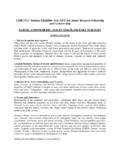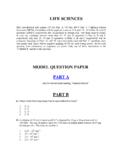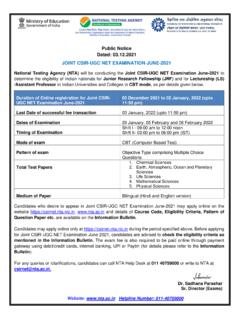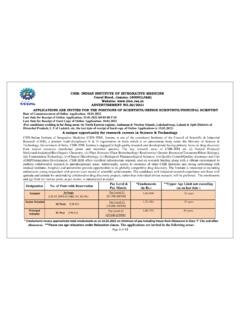Transcription of CSIR-UGC National Eligibility Test (NET) for Junior ...
1 CSIR-UGC National Eligibility Test (NET) for Junior Research Fellowship and Lecturer-ship PHYSICAL SCIENCES P AR T A CORE I. Mathematical Methods of Physics Dimensional analysis. Vector algebra and vector calculus. Linear algebra, matrices, Cayley-Hamilton Theorem. Eigenvalues and eigenvectors. Linear ordinary differentia l equations of firs t & second order, Special functions (Hermite, Bessel, Laguerre and Legendre functions). Fourier series, Fourier and Laplace transforms. Elements of complex analysis, analytic functions; Taylor & Laurent series; poles, residues and evaluation of integrals. Elementary probabilit y theory, random variables, binomial, Poisson and normal distributions.
2 Central limit theore m. II. Classical Mechanics Newton s laws. Dynamical systems, Phase space dynamics, stability analysis. Central force motions. Two body Collisions - scattering in laboratory and Centre of mass frames. Rigid body dynamics- moment of inertia tensor. Non-inertial frames and pseudofo rces. Variational principle. Generaliz ed coordinates. Lagrangian and Hamiltonian formalism and equations of motion. Conservation laws and cyclic coordinates. Periodic motion: small oscilla tions, normal modes. Special theory of relativity- Lorentz transformations, re lativistic kinematics and mass energy equivalence.
3 III. Electromagnetic Theory Electrostatics: Gauss s law and its applications, Laplace and Poisson equations, boundary value problems. Magnetostatics: Biot-Savart law, Ampere's theorem. Electromagnetic induction. Maxwell's equations in free space and linear isotropic media; boundary conditions on the fi elds at interfa ces. Scalar and vector potentia ls, gauge invariance. Electromagnetic waves in free space. Dielectrics and conductors. Reflection and refraction, polarization, Fresnel s law, interference, coherence, and diffraction. Dynamics of charged particles in static and uniform electromagnetic fields. IV.
4 Quantum Mechanics Wave-particle duality. Schr dinger equation (time-dependent and time-independent). Eigenvalue problems (partic le in a box, harmonic oscillator, etc.). Tunneling through a barri er. Wave-function in coordinate and momentum representations. Commutators and Heisenberg uncertainty principle. Dirac notation for state vectors. Motion in a central potential: orbital angular momentum, angular momentum algebra, spin, addition of angular momenta; Hydro gen atom. Stern-Gerlach experiment. Time- independent perturbation theory and applic ations. Variational method. Time dependent perturbation theory and Fermi's golden ru le, selection rules.
5 Identic al particles, Pauli exclusion principle, spin-statistic s connection. V. Thermodynamic and Statistical Physics Laws of thermodynamics and their consequences. Thermodynamic potentia ls, Maxwell re lations, chemical potential, phase equilibria. Phase space, micro- and macro-states. Micro-canonical, canonical and grand-canonical ensembles and partition fu nctions. Free energy and its connection with thermodynamic quantities. Classical and quantum statistics. Ideal Bose and Fermi gases. Principle of detailed balance. Blackbody radiation and Planck's distribution law. VI. Electronics and Experimental Methods Semiconductor devices (diodes, junctions, transistors, field effect devices, homo- and hetero-junction devices), device structure, device characteristics, frequency dependence and applications.
6 Opto-electronic devices (solar cells, photo-detectors, LEDs). Operational amplifiers and their applications. Digital techniques and applications (registers, counters, comparators and similar circuits). A/D and D/A converters. Microprocessor and microcontroller basics. Data interpretation and analysis. Precision and accuracy. Error analysis, propagation of errors. Least squares fitting, P AR T B ADVANCED I. Math ematical Methods of Physics Green s function. Partia l differential equations (Laplace, wave and heat equations in two and three dimensions). Elements of computational techniques: root of functions, interpolation, extrapolation, integration by trapezoid and Simpson s rule, Solution of first ord er differential equation using Runge- Kutta method.
7 Finite difference methods. Tensors. Introductory group theory : SU(2), O(3). II. Classical Mechanics Dynamical systems, Phase space dynamics, stability analysis. Poisson brackets and canonical transformations. Symmetry, invariance and Noether s theorem. Hamilton-Jacobi theory. III. Electromagnetic Theory Dispersion relations in plasma. Lorentz invariance of Maxwell s equation. Transmission lines and wave guides. Radiation- from moving charges and dipoles and retarded potentials. IV. Quantum Mechanics Spin-orbit coupling, fine structure. WKB approximation. Elementary theory of scattering: phase shifts, partial waves, Born approximation.
8 Relativistic quantum mechanics: Klein-Gordon and Dirac equations. Semi-classical theory of radiation. V. Thermodynamic and Statistical Physics First- and second-order phase transitions. Diamagnetism, paramagnetis m, and ferromagnetis m. Ising model. Bose-Einstein condensation. Diffusion equation. Random walk and Brownian motion. Introduction to nonequilibrium processes. VI. Electronics and Experimental Methods Linear and nonlinear curve fitting, chi-square test. Transducers (temperature, pressure/vacuum, magnetic fields, vibration, optical, and partic le detectors). Measurement and control. Signal conditioning and recovery.
9 Impedance matching, amplif ication (Op-amp based, instrumentation amp, feedback), filtering and noise reduction, shielding and grounding. Fourier transforms, lock-in detector, box-car integrator, modulation techniques. High frequency devices (including generators and detectors). VII. Atomic & Molecular Physics Quantum states of an electron in an atom. Electron spin. Spectrum of helium and alkali atom. Relativistic corrections for energy levels of hydro gen atom, hyperfine structure and isotopic shift, width of spectrum lines, LS & JJ couplings. Zeeman, Paschen-Bach & Stark effects. Electron spin resonance. Nuclear magnetic resonance, chemical shift.
10 Frank-Condon principle. Born-Oppenheimer approximation. Electronic, rotational, vibrational and Raman spectra of diatomic molecules, selection rules. Lasers: spontaneous and stimulated emission, Einstein A & B coefficients. Optical pumping, population inversion, rate equation. Modes of resonators and coherence length. VIII. Condensed Matter Physics Bravais lattices. Reciprocal lattice. Diffraction and the structure factor. Bonding of solids. Elastic properties, phonons, lattic e specific heat. Free electron theory and electronic specific heat. Response and relaxation phenomena. Drude model of electrical and thermal conductivity.

















